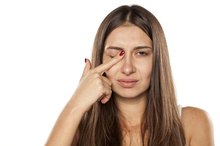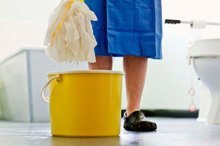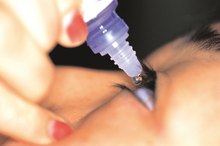Pediatric ear drops are used in two of the most common diseases in pediatrics, otitis media and otitis externa. Otitis media is inflammation and/or infection of the inner ear behind the eardrum. Otits externa is inflammation and/or infection of the ear canal in front of the eardrum. There are several types of drops used to treat specific symptoms or diseases.
If you are experiencing serious medical symptoms, seek emergency treatment immediately.
Cerumenolytics
Cerumenolytics are ear drops designed to soften or remove ear wax or cerumen. The two active ingredients in most of these preparations are carbamide peroxide (Brand names: Auraphene-B, Auro Ear Drops, Debrox, Mollifene and Murine Earwax Removal) and triethanolamine polypeptide oleate (Brand name: Cerumenex). These drops are generally available without a prescription.
- Cerumenolytics are ear drops designed to soften or remove ear wax or cerumen.
Local Anesthetic Drops
How Much Glycerin Is Needed to Clean Out Ear Wax?
Learn More
Local anesthetic drops are designed to reduce pain of the ear due to otitis media or otitis externa. Anesthetic drops include Benzocaine (Brand name: Americaine Otic and Otocain) and Pramoxine. These drops are generally available by prescription only.
Steroid Ear Drops
Steroid ear drops are used to treat inflammation of the skin of the ear canal. The common active ingredients are hydrocortisone; dexamethasone (Brand name: Dexasol); and fluocinolone acetonide (Brand name: DermOtic Oil Ear Drops). These drops are available only by prescription.
Anti-infective Ear Drops
How to Use Debrox Earwax Removal
Learn More
Anti-infective ear drops are designed to treat an infection of the ear canal due to otitis externa or otitis media in children that have functioning tubes in the eardrum. The antibiotic anti-infectives that are readily available are Neomycin and Polymyxin B; ciprofloxacin (Cetraxal); ofloxacin (Floxcin Otic); gentamycin; gramicidin; nystatin; and framycetin. The non-antibiotic anti-infectives are chloroxylenol; and acetic acid or vinegar (Brand Name: Acetasol). Ear drops that contain antibiotics usually require a prescription.
- Anti-infective ear drops are designed to treat an infection of the ear canal due to otitis externa or otitis media in children that have functioning tubes in the eardrum.
- The antibiotic anti-infectives that are readily available are Neomycin and Polymyxin B; ciprofloxacin (Cetraxal); ofloxacin (Floxcin Otic); gentamycin; gramicidin; nystatin; and framycetin.
Otitis Externa – Swimmer’s Ear Drops
Ears drops used in the prevention of swimmer’s ear are generally designed to remove moisture in the ear and/or reduce the pH so that the common fungi and bacteria do not grow. These drops include acetic acid (Brand name: Acetasol, Vosol) or isopropyl alcohol (Brand Name: Swim Ear, Auro-Dri). All of the drops used for treatment are combination drops that treat both the inflammation and infection aspects of the disease. The prevention drops are available without a prescription.
- Ears drops used in the prevention of swimmer’s ear are generally designed to remove moisture in the ear and/or reduce the pH so that the common fungi and bacteria do not grow.
Combination Ear Drops
Combination ear drops have more than one active ingredient and are generally designed to treat multiple aspects of otitis media or otitis externa. Analgesic ear drops are use to reduce or eliminate pain generally in association with otitis media.
Another combination ear drop is an antibiotic and steroid together, which are used to treat primarily otitis externa. These drops require a prescription 1.
- Combination ear drops have more than one active ingredient and are generally designed to treat multiple aspects of otitis media or otitis externa.
Homemade Ear Drops
Homemade drops are made to mimic commercially available drops to prevent swimmer’s ear. Three of the most common preparations include equal parts white vinegar and isopropyl alcohol or ethanol (Vodka); straight white vinegar; and straight ethanol. These are designed to remove moisture from the ear canal and lower the pH to prevent bacterial or fungal growth.
Related Articles
References
- "Physicians' Desk Reference"; Kevin D. Sanborn; et. al.; 2007.
- Centers for Disease Control and Prevention (CDC), Office of the Associate Director for Communication, Division of News and Electronic Media. Swimmer’s Ear Responsible for Nearly a Half Billion in Health Care Costs. CDC Online Newsroom. Published May 19, 2011.
- Hui CP. Acute otitis externa. Paediatr Child Health. 2013;18(2):96-101. doi:10.1093/pch/18.2.96
- American Academy of Otolaryngology—Head and Neck Surgery. Topical Therapy for Acute Otitis Externa (Swimmer’s Ear). Patient Information - Frequently Asked Questions. (PDF). Published February 2014.
- P S, Baugh R. Acute Otitis Externa: An Update. American Family Physician. Published December 2012.
- Wang X, Winterstein AG, Li Y, Zhu Y, Antonelli PJ. Use of Systemic Antibiotics for Acute Otitis Externa: Impact of a Clinical Practice Guideline. Otol Neurotol. 2018;39(9):1088-1094. doi: 10.1097/MAO.0000000000001955
- InformedHealth.org [Internet]. Cologne, Germany: Institute for Quality and Efficiency in Health Care (IQWiG); 2006-. Which ear drops help in the treatment of outer ear infections? Updated November 2017.
- Aslam B, Wang W, Arshad MI, et al. Antibiotic resistance: a rundown of a global crisis. Infect Drug Resist. 2018;11:1645-1658. doi:10.2147/IDR.S173867
- Sjoukes A, Venekamp RP, van de Pol AC, et al. Paracetamol (acetaminophen) or non-steroidal anti-inflammatory drugs, alone or combined, for pain relief in acute otitis media in children. Cochrane Database of Systematic Reviews. 2016;(Intervention). doi:10.1002/14651858.CD011534.pub2
- Levi JR, Brody RM, Mckee-cole K, Pribitkin E, O'reilly R. Complementary and alternative medicine for pediatric otitis media. Int J Pediatr Otorhinolaryngol. 2013;77(6):926-31. doi: 10.1016/j.ijporl.2013.03.009
- Holmer N. Swimmer’s Ear (Otitis Externa). American Speech-Language-Hearing Association (ASHA). Published 2015.
- Rosenfeld RM, Schwartz SR, Cannon CR, Roland PS, Simon GR, Kumar KA, et al. Clinical practice guideline: Acute otitis externa. 2014. Otolaryngology-Head and Neck Surgery. doi: 10.1177/0194599813517083
Resources
Writer Bio
Dr. Marvin Phillips, known affectionately as Dr. Phil, retired from the practice of pediatrics in 1999. He currently is the CEO of a start-up ambulance service, and has been writing since college. He has published works in "Circulation Research" and "The Anatomical Record." He has professional experience in building, electrical,plumbing, woodworking, cabinetry and automobile restorations.








